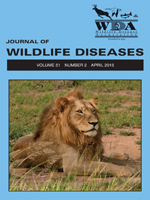The coccidian parasite Toxoplasma gondii infects humans and warm-blooded animals worldwide. The ecology of this parasite in marine systems is poorly understood, although many marine mammals are infected and susceptible to clinical toxoplasmosis. We summarized the lesions associated with T. gondii infection in the California sea lion (Zalophus californianus) population and investigated the prevalence of and risk factors associated with T. gondii exposure, as indicated by antibody. Five confirmed and four suspected cases of T. gondii infection were identified by analysis of 1,152 medical records of necropsied sea lions from 1975–2009. One suspected and two confirmed cases were identified in aborted fetuses from a sea lion rookery. Toxoplasmosis was the primary cause of death in five cases, including the two fetuses. Gross and histopathologic findings in T. gondii-infected sea lions were similar to those reported in other marine mammals. The most common lesions were encephalitis, meningitis, and myocarditis. The antibody prevalence in stranded, free-ranging sea lions for 1998–2009 was 2.5% (±0.03%; IgG titer 640). There was an increase in odds of exposure in sea lions with increasing age, suggesting cumulative risk of exposure and persistent antibody over time. The occurrence of disseminated T. gondii infection in aborted fetuses confirms vertical transmission in sea lions, and the increasing odds of exposure with age is consistent with additional opportunities for horizontal transmission in free-ranging sea lions over time. These data suggest that T. gondii may have two modes of transmission in the sea lion population. Overall, clinical disease was uncommon in our study which, along with low prevalence of T. gondii antibody, suggests substantially less-frequent exposure and lower susceptibility to clinical disease in California sea lions as compared to sympatric southern sea otters (Enhydra lutris nereis).
How to translate text using browser tools
1 April 2015
EPIDEMIOLOGY AND PATHOLOGY OF TOXOPLASMA GONDII IN FREE-RANGING CALIFORNIA SEA LIONS (ZALOPHUS CALIFORNIANUS)
Daphne Carlson-Bremer,
Kathleen M. Colegrove,
Frances M. D. Gulland,
Patricia A. Conrad,
Jonna A. K. Mazet,
Christine K. Johnson
ACCESS THE FULL ARTICLE

Journal of Wildlife Diseases
Vol. 51 • No. 2
April 2015
Vol. 51 • No. 2
April 2015
California sea lions
epidemiology
marine mammal
pathology
protozoal disease
Toxoplasma gondii
Zalophus californianus




